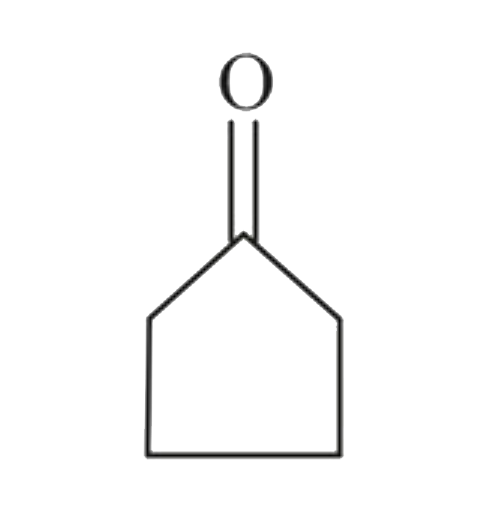The compound 'D' is




The correct Answer is:A
To solve the problem step by step, we need to analyze the transformations of the compound A (C₄H₈O) to find out what compound D is.
Step 1: Identify Compound A
The molecular formula C₄H₈O suggests that compound A could be a simple alcohol or an ether. A common structure that fits this formula is CH₂=CH-CH₂-CH₂OH (butanol) or CH₃-CH₂-CH₂-CHO (butanal). However, for this problem, we will consider it as a primary alcohol, specifically 1-butanol (C₄H₈O).
Step 2: Reaction of A with Acid
When 1-butanol (A) is treated with an acid (H₃O⁺), it can undergo a rearrangement or ring expansion. In this case, it can form cyclobutanol (B) through a ring formation reaction.
B = Cyclobutanol
Step 3: Oxidation of B with CrO₃ and Acetic Acid
Cyclobutanol (B) is then oxidized using chromium trioxide (CrO₃) in acetic acid. This oxidation process typically converts alcohols to ketones or aldehydes. In this case, cyclobutanol is oxidized to cyclobutanone (C).
C = Cyclobutanone
Step 4: Reaction of C with Diazomethane
Cyclobutanone (C) is then treated with diazomethane (CH₂N₂) under heating conditions. Diazomethane is known to react with carbonyl compounds to form methyl esters. In this case, it will insert a CH₂ group into the cyclobutanone structure, resulting in the formation of cyclopentanone (D).
D = Cyclopentanone
Conclusion
The compound D is cyclopentanone.
Summary of Steps:
1. Identify A as 1-butanol (C₄H₈O).
2. Convert A to B (cyclobutanol) using acid.
3. Oxidize B to C (cyclobutanone) using CrO₃ and acetic acid.
4. React C with diazomethane to form D (cyclopentanone).
The molecular formula C₄H₈O suggests that compound A could be a simple alcohol or an ether. A common structure that fits this formula is CH₂=CH-CH₂-CH₂OH (butanol) or CH₃-CH₂-CH₂-CHO (butanal). However, for this problem, we will consider it as a primary alcohol, specifically 1-butanol (C₄H₈O).
When 1-butanol (A) is treated with an acid (H₃O⁺), it can undergo a rearrangement or ring expansion. In this case, it can form cyclobutanol (B) through a ring formation reaction.
Cyclobutanol (B) is then oxidized using chromium trioxide (CrO₃) in acetic acid. This oxidation process typically converts alcohols to ketones or aldehydes. In this case, cyclobutanol is oxidized to cyclobutanone (C).
Cyclobutanone (C) is then treated with diazomethane (CH₂N₂) under heating conditions. Diazomethane is known to react with carbonyl compounds to form methyl esters. In this case, it will insert a CH₂ group into the cyclobutanone structure, resulting in the formation of cyclopentanone (D).
The compound D is cyclopentanone.
1. Identify A as 1-butanol (C₄H₈O).
2. Convert A to B (cyclobutanol) using acid.
3. Oxidize B to C (cyclobutanone) using CrO₃ and acetic acid.
4. React C with diazomethane to form D (cyclopentanone).
Similar Questions
Knowledge Check
H2C=CH−CH2−C∣OHH−CH3SOCl2−−−−→Pyridine(A)O3/Zn−−−−→(H2O)(B)C5H9ClONaBH4−−−−→(C)
Compound (C) is :ACH3−OH∣CH−CH2−C∣ClH−CH3BHOCH2−CH2−CH2−CH2−CH2−CH2−ClCHO−CH2−CH2−CH2−Cl∣CH−CH3DHO−CH2−CH2−C∣ClH−CH2−CH3CH3−O∣∣C−O−HNaH14CO3−−−−−→(A)(gas)(i)PhMgBr−−−−−−−→(ii)H3O⊕(B)
CH3−O∣∣S∣∣O−O−HNaH14CO3−−−−−→(C)gas(i)PhMgBr−−−−−−−→(ii)H3O⊕(D)
Product (B) and (D) in the above reaction are :APh−O∣∣C−O−H,Ph−O∣∣S∣∣O−O−HBPh−O∣∣C14−O−H,Ph−O∣∣S−O−HCPh−O∣∣C14−O−H,Ph−O∣∣C14−O−HDPh−O∣∣C−OH,Ph−O∣∣S−O−H
complete the following reactions:
a. C6H6+MeCOCIBenze≠(A) AICI3−−−→ B HNO3––––––H(2)SO4)→ C NaBH4−−−−→ D H2SO4−−−→Δ E
View SolutionConsider the following sequence of reactions
ACrO3−−→B(C4H8O3)Warm−−−→CH3O∣∣CCH3+CO2
The compound (A) is :
View Solution (i)CH3CHO−−−−−−−→(ii)H3O+ (A) HBr−−→ (B)
(i)CH3CHO−−−−−−−→(ii)H3O+ (A) HBr−−→ (B)
The compounds (A) and (B)
View Solution Me−≡−HNaNH2−−−−−−→+liq.NH3 (C ) H3O⊕−−−→ (D)
Me−≡−HNaNH2−−−−−−→+liq.NH3 (C ) H3O⊕−−−→ (D)
the final product (D) is:
View SolutionCH3−CH2−O∣∣C−OAgBr2−−→CCl4X(1) Li−−−→(2) CuIYCH3−CH2−Br−−−−−−−−−→dry etherZ
View SolutionCH3−O∣∣C−CH2−CH3∣C∣CH3−CHOKOH,H2O−−−−−−→Δ product (C7H10O) :
View Solution
